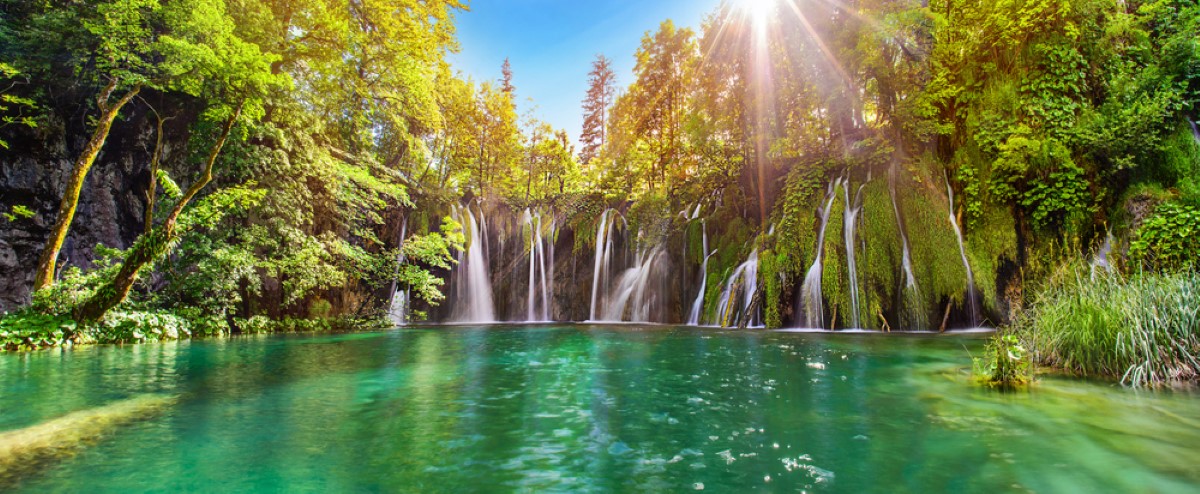
Plitviče Lakes National Park is a forest reserve located in the heart of Croatia and is home to 16 interconnecting lakes, waterfalls, and a limestone canyon. Hiking trails and footpaths wind around the water, where you can observe a 78m sparkling waterfall.
Over many years, waters that flow over chalk and limestone created natural dams, producing a series of stunning lakes, waterfalls, and caves. To this day, this natural phenomenon continues to carve out more dams. Wildlife in the forests includes wolves, bears, and rare marsh birds. Clusters of butterflies float along 11 miles of wooden bridges and trails that wind around the edges and across the crystal-clear water.
The Plitvice Lakes National Park is the largest and oldest national park in Croatia. It is well-known for its many turquoise lakes and breathtaking waterfalls. The landscape is incredibly diverse, helping the National Park achieve worldwide fame.
Plitvice Lakes is one of the most unusual visions to see within Croatia. With comfortable walking trails, bridges hung over the turquoise water, striking views, and breathtaking waterfalls, visitors of any age can appreciate these natural settings.
The National Park is home to four hiking trails, lakes of varying levels, seven walkways through the park, and two separate entrances. The possibilities of adventure and exploration are endless!
Each lake varies in striking colors from emerald green to deep blue to turquoise, depending on the type of minerals it contains and the light of the day. The waterfalls truly take the scenic views to the next level.
It is so incredibly scenic that the National Park became a UNESCO World Heritage Site in 1979. However, it’s not really the lakes that are the main attraction, but the hundreds of waterfalls that link all of them. You would probably not be surprised to know that this is one of Croatia’s most beloved and well-known tourist attractions, hosting over 1 million visitors every year. Most tourists arrive in the summer, so you should expect large crowds if you decide to visit between June and August.
The National Park covers 30,000 hectares and is located in the lower section of the Dinarides in the heart of Croatia. The landscape is an enchanting mix of meadows and forests. The lakes are arranged into upper and lower lakes. The upper lakes formed dolomites and gradual shores, surrounded by thick forests. The lower lakes are shallower and located within the limestone canyon, and contain much steeper slopes.
From the southern entrance, travelers can stroll the shore to Kozjak Lake, the park’s largest lake. Follow the path to the unbelievable lower lakes, with caves, forests, cliffs, and waterfalls. You will soon come across Milanovac Lake with its emerald waters before the path takes you to Gavanovac Lake and its soaring cliffs. A wooden path cuts across the north bank, around Kaluđerovac Lake, and past two breathtaking waterfalls.
Traveling through the National Park can be done using a combination of boat, tourist bus, and hiking. The Park can provide detailed maps, and the information booths can answer any questions you may have.
After millennia of biochemical and geological processes that form calcium carbonate deposits, natural dams were created, known as tufa barriers. This tufa formation constitutes a relationship with the local algae, moss, and aquatic bacteria. All of this combined makes an exceptionally stunning view. Besides the striking landscape and biochemical processes that shape the lakes, the National Park is home to unique biodiversity.
To put it simply, it is absolutely gorgeous here. Around every corner is another breathtaking view. Be prepared to take lots of photos! Explore waterfalls, lakes, and incredible trails for a unique vacation.
Can’t Miss: Plitvice Lakes National Park is Croatia’s #1 most visited national park and UNESCO world heritage site. The lakes themselves are the main attraction here. They’re known for the 16 interconnecting lakes, dense forests and the waterfalls that surround them. These waterfalls flow stronger in the early summer, and travelers are able to canoe or kayak on some of the lakes themselves. Enjoy this stunning natural wonder.
Insider tip: There are two main loops around the park–a shorter one and a longer one. The shorter one takes about two to three hours. The longer one takes three to four hours. Either path offers amazing views of the beautiful inland waters. Choose which path is right for you!
Restaurants: If you’re looking for a place to relax, Restaurant Degenja is a great spot with its rural setting and views of the area. The restaurant serves traditional Croatian dishes like ćevapi (minced meat grilled on skewers) and peka (lamb or pork cooked under a bell-shaped lid). After your meal, take a walk around the restaurant’s terrace and enjoy the natural beauty of Croatia’s most famous national park.